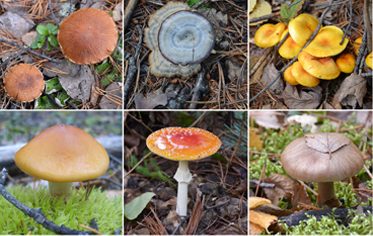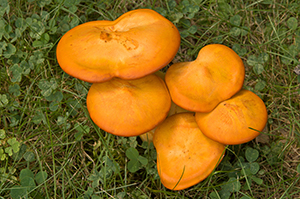Poisonous Mushrooms Pose Danger as More People Forage for Locally Grown Food, Rutgers Experts Say
A rising interest in foraging spurs an education campaign on the hazards of eating mushrooms picked in the wild

If you or someone you know has consumed a mushroom picked in the wild, do not wait for symptoms to develop and call New Jersey Poison Control (800-222-1222) immediately.If parts of the mushroom or other examples of the mushroom are available, take a digital photograph of it next to an object, such as a coin, for a sense of scale and save mushroom fragments in a paper bag, not a plastic one. New Jersey Poison Control will arrange for an identification of the mushroom by a mycologist via photo or a home visit.
While walking in the field behind her Lambertville home, Lauren Johnson became enchanted by a bright-orange and yellow mushroom growing on the side of a tree. Johnson, who often forages with her husband, believed her find to be a Chicken of the Woods, an edible variety – but refrained from cooking it until she was certain. “We’re very wary,” she says, “and always bring mushrooms to experts who can identify them before we eat them.”
Unfortunately, many people who forage and are not as cautious can find themselves gravely sick from mushroom poisoning.
“There is a saying, ‘There are old mushroom pickers and bold mushroom pickers, but there are no old, bold mushroom pickers,’” says Bruce Ruck, director of drug information and professional education for New Jersey Poison Control, based at Rutgers New Jersey Medical School in Newark.
Nationwide, poison control centers answer more than 6,000 calls annually regarding the consumption of poison mushrooms. Of these cases, about 2,500 are treated in health care facilities, with more than 500 cases resulting in serious illness.
Last year, New Jersey Poison Control fielded 141 calls about potential poisonings, 41 of which led to hospital treatment. In recent years, there have been several deaths of animals and humans reported, says Ruck, including the death of a Mercer County mother who unknowingly picked and used lethal Amanitas in a stew and served it to her family, who were sickened but survived. To date this year, 113 cases of mushroom poisonings have been reported in New Jersey.
Symptoms of mushroom poisoning, which can manifest from as soon as 20 minutes to a few days after consumption, range from intense vomiting, cramps and diarrhea, to liver and kidney damage, to death. “Eating even a few bites of certain mushrooms can cause severe illness,” explains Ruck.
Most troubling to poison control experts is the fact that foraging – often by those without expertise – is growing in mainstream popularity. The increasing interest in foraging may be due to the rise of the locovore movement, which promotes eating locally sourced foods, experts say. The motivation may also be to save money. But, Ruck says, “unless you are a mycologist, it is difficult to tell the difference between a toxic and non-toxic mushroom.”

Many cases of mushroom poisonings come from immigrants who are accustomed to foraging in their home countries and are unaware of the differences in mushrooms found in the United States. “Appearances can be deceiving,” Ruck says. “Mushrooms growing in New Jersey may look like edible varieties from other parts of the country or world, but are actually toxic. Also, poisonous and non-poisonous mushrooms can grow side by side.” His message to those who want to eat what they pick: “When in doubt, throw it out.”
More than 5,000 species of mushrooms grow in the United States. Of these, about 100 are poisonous and a dozen are considered lethal. Most poison-related deaths result from people consuming mushrooms belonging to the genus Amanita – Death Caps, Destroying Angels and Fool’s Mushroom – which can easily be mistaken for nonpoisonous varieties, says James White, a professor at Rutgers School of Environmental and Biological Sciences who teaches a course, “Edible and Poisonous Mushrooms.” Many popular varieties have toxic look-alikes. “For example, poisonous false morels can be mistaken for highly sought after edible morels and Jack-O’Lantern mushrooms may resemble chanterelles,” he says. “In addition, people have varying degrees of sensitivities with mushrooms. What might be fine for one person to consume might make another sick.”
Ruck urges instructing children not even to touch a wild mushroom – “They could pick one and put it in their mouth before you know it,” he explains – and to safeguard pets by keeping them on a leash and monitoring yards for mushroom growth after rain.
Have a question about a mushroom? Contact the New Jersey Poison Control at 800-222-1222.